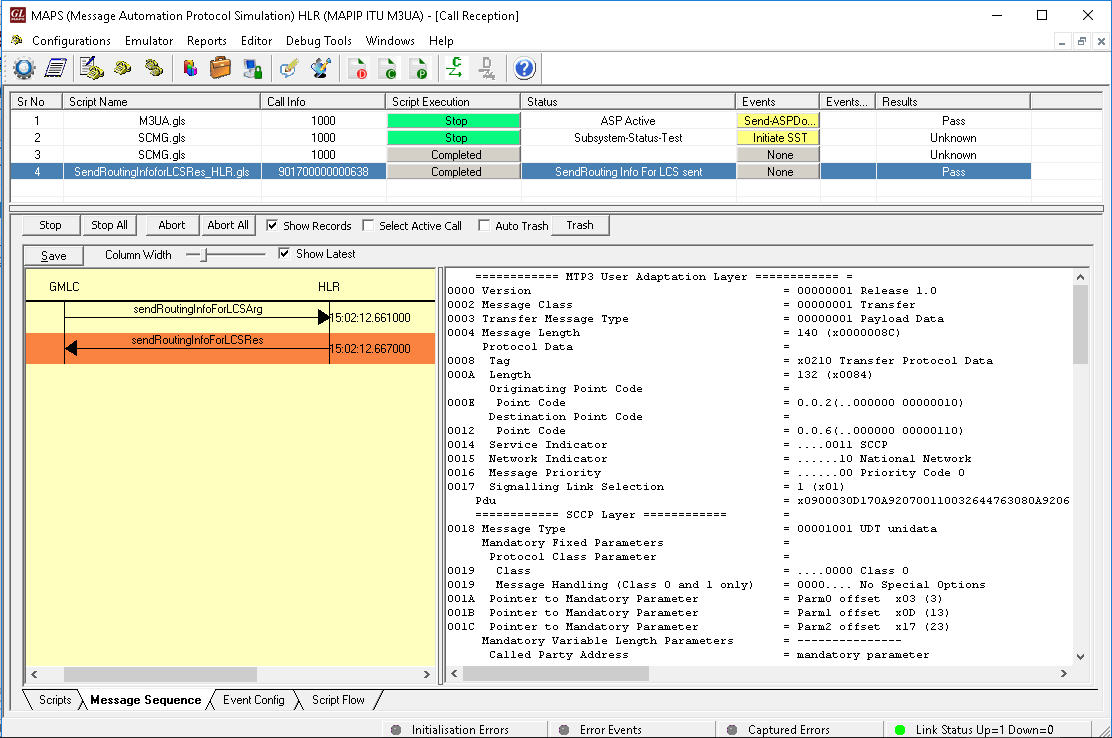GL Announces Simulation of Location Based Services in UMTS Mobile Networks (Part 3)
Welcome to another April 2017 issue of GL Communications' Newsletter providing information and insight into our Location Services (LCS) Test Suite to support simulation of location services in UMTS networks.
This is the third and last part of our “Simulation of Location based Services” newsletter. In the preceding weeks, the focus was on GSM and LTE Networks respectively. This week, the focus is on
- the important elements, interfaces, and location request and response procedures in the UMTS network
- how to test these using MAPS™ IuPC and MAPS™ MAP IP (Lg and Lh) protocol simulators

Location Services (LCS) Network Architecture
Overview
The LCS architecture in UTRAN follows a client/server model with the positioning functionality distributed across UMTS nodes such as, Radio Network Controller (RNC), Stand Alone Serving Mobile Location Center (SMLC), Mobile Serving Centre (MSC), Home Location Register (HLR), and Gateway Mobile Location Center (GMLC). The Gateway Mobile Location Center (GMLC) acts as the server node providing information to external LCS Clients
As depicted in the diagram above, some of the important interfaces participating in the location request and response in UMTS network are summarized below -
- Lg interface - The MSC/VLR and SGSN is accessible to the GMLC via the Lg interface
- Lh interface - The HLR is accessible to the GMLC via the Lh interface
- Lp interface - Interface between Peer SMLCs
- Lr interface - Interface between Peer GMLCs
- Le interface - Interface between GMLC and LCS clients
- IuPC interface - Interface between RNC and SAS (Stand Alone SMLC)
Location estimation in UMTS network uses Positioning Calculation Application Part (PCAP) protocol over IuPC interface between RNC and the Stand-Alone SMLC (SAS). PCAP consists of Elementary Procedures (EPs) initiating message and possibly a response message. Following are the functions of IuPC interface.
- Management of Position Calculation Functions
- Management of SAS Centric Position Functions
- Management of Information Exchange Functions
Location estimation uses hybrid positioning methodologies, may be UE-based, network-based, UE-assisted, network-assisted and/or combination of these methods. The main difference is that the network-based measurements do their calculations at the infrastructure level, while the UE based measurements do their calculations at the device.
The Standard Positioning Methods in UTRAN can be summarized as below -
- Cell coverage based positioning method (Network Based)
- OTDOA positioning method (Network Based)
- A-GNSS based positioning methods (Handset Based)
- UTDOA positioning method (Network Based)
LCS Network Simulation using MAPS™
GL’s MAPS™ LCS Test Suite is comprises of multiple products working in tandem to support simulation of location services on GSM, UMTS, and LTE networks and is briefly discuss below.
Specifically, to support location services in UMTS network, GL’s MAPS™ MAP IP signaling emulator is enhanced to simulate Lg, and Lh interfaces using MAP protocol for estimating the position of mobile devices (mobile phones, wireless personnel, digital assistants and so on) independent of underlying network technology. Added to this is MAPS™ IuPC interface emulator to support UMTS IuPC interface procedures between RNC and SAS using PCAP protocol.
GL's MAPS™ supports simulation of different Positioning Methods and Position Estimation of a Mobile Stations (MS) in universal coordinates. The estimate is expressed in terms of the geographical shapes and is composed of the type of shape plus the encoding of the shape itself. The Location Estimate parameters such as Type of Shape and coordinates can be input through conventional user profiles or can be fetched from a CSV file every time it sends the location estimate to the client. This selection is to be made by the user.
These coordinates indicate different position of MS at different intervals of time and report is sent either periodically at specified time duration or at once when requested.
Typical call flow simulation of location based services messages by MAPS™ is as shown below -
Complete Call Flow of LCS Procedures with MAPS™ IuPC, and MAPS™ MAP IP (Lg, Lh) Emulators
Lg, Lh Interfaces
MAPS™ MAP IP supports both server and client simulation of Mobile Application Part (MAP) signaling protocol over Lg, Lh interfaces. It allows testing SGSN/MSC entities in UMTS/GSM network with GMLC and vice-versa.
Typical procedures supported over Lg and Lh interface are:
- MAP-Provide-Subscriber-Location - used by a GMLC to request the location and optionally, velocity, of a target UE
- MAP-Subscriber-Location-Report - used by a SGSN to provide the location of a target UE to a GMLC
- MAP-Send-Routing-Info-for-LCS - used between the GMLC and the HLR to retrieve the routing information needed for routing LCS request to the servicing MSC/SGSN
The following screenshot depicts MAPS™ MAP IP configured as GMLC simulating Lg interface LCS procedure.
IuPC Interface
MAPS™ IuPC supports simulation of location service operation using PCAP protocol, between the RNC (Radio Network Controller) and SAS (Stand Alone SMLC) exchanging LCS messages as per 3GPP TS 25.305 specification.
Typical procedures supported over IuPC interface are:
- Positioning Calculation Service - This procedure initiates a POSITION CALCULATION REQUEST message from the RNC to the SAS. When the SAS receives this message, it shall calculate the UE position. This includes the following class 2 Elementary Procedures -
- Position Calculation
- Position Parameter Modification
- Information Exchange Service - RNC sends this message to request the initiation of an information exchange with a SAS. This includes the following class 2 Elementary Procedures -
- Information Exchange Initiation
- Information Reporting
- Information Exchange Termination
- SAS Centric Position Service - This procedure enables the RNC to interact with a SAS in the process of performing a position estimate of a UE. This includes the following class 2 Elementary Procedures -
- Position Initiation
- Position Activation
- Position Periodic Report
- Position Periodic Termination
The following screenshot depicts MAPS™ IuPC configured as SAS (Stand Alone SMLC) simulating IuPC interface LCS procedure.




 Back to Newsletter Index Page
Back to Newsletter Index Page